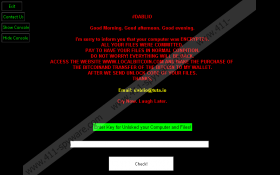Dablio Ransomware Removal Guide
You do not want to face Dablio Ransomware, that’s for sure. This file-encrypting ransomware is all about extorting money from its victims, and, unfortunately, because it takes personal files hostage, some victims are likely to give in. At this point, it is not yet clear whether or not this infection is proliferating actively, but there is no doubt that it is a real threat that must be investigated. According to our malware experts, it is most likely to invade operating systems with the help of misleading spam emails and RDP vulnerabilities. Without a doubt, you want to become more cautious about the emails you open, the attachments you click, and the vulnerabilities that are left unpatched. You also want to backup your personal files because if the infection encrypts files, restoring them is unlikely to be possible. However, if backups exist, the corrupted files can be replaced in no time. The end game here, in any scenario, is deleting Dablio Ransomware, and we can show you the way.
Dablio Ransomware does not waste any time, and it should start encrypting data as soon as it is executed. The launcher file should be dropped in the %WINDIR%\SoftwareDistribution\Download\ folder, and the icon of the file should represent Google Chrome. Our researchers indicate that a few possible name options are “Cmd.exe” and “Dablio.exe,” but, of course, this is a variable that could change. Even the location could be different, and that is what makes the manual removal of Dablio Ransomware quite complicated. More on that – later on. Before you can even start thinking about the removal processes, you need to unveil the infection and figure out what has happened. Since it is a silent threat, you should be surprised to find that your files cannot be opened. Of course, you might not get the chance to see that files are encrypted and that the “(encrypted)” prefix is added to their names because as soon as files are encrypted, the threat is supposed to launch a window representing a ransom note. This window goes full screen, and exiting it might seem impossible because the “Exit” option does not work, and the Task Manager and Registry Editor tools get disabled.
The purpose of the message delivered by Dablio Ransomware is to make you email dablio@tuta.io. You might be pushed into doing this if you decide that you want to get more information about the ransom that is demanded in return for the recovery of files. The message declares that files can be recovered only after a ransom is paid and after the so-called “unlock code” is sent to them, but how much should you pay? How should you pay the ransom? And how will cyber criminals know how to contact you after the fact? These are all logical questions, and so you might decide that contacting cyber criminals is a good option. It is not because you do not want cyber attackers knowing your email address. You also do not want to be involved with the payment of the ransom because that is unlikely to get you where you want. The developer of Dablio Ransomware would gladly take your money, but you should not assume that cyber criminals would ever help you out, even if that is their promise.
Can you enable Registry Editor, Command Prompt, and Task Manager yourself? You do not really have an option, and you have to do it. This might be overwhelming if you are not familiar with the Group Policy Editor, but you should have no trouble if you just follow the instructions below carefully. If you face problems, let us know via the comments below. When it comes to the removal of Dablio Ransomware, you have more options. You can try to find and delete the threat manually, or you can employ an anti-malware program that would do it for you. You certainly should have no reservations about employing this program if you want to have your system secured. After you are done removing Dablio Ransomware components, figure out how to backup your files in the future to ensure that they are safe no matter what attacks your operating system.
How to delete Dablio Ransomware
- To close the ransomware window, click Show Console.
- Simultaneously tap Win+R to launch RUN.
- Enter gpedit.msc and click OK to access Local Group Policy Editor.
- Click select User Configuration and then double-click Administrative Templates.
- Go to System, open these menus and choose Disabled for all of them:
- Ctrl+Alt+Delete Options
- Prevent access to the command prompt
- Prevent access to registry editing tools
- Simultaneously tap Win+E to launch Explorer.
- Enter %WINDIR%\SoftwareDistribution\Download\ into the field at the top.
- Right-click and Delete the ransomware launcher file (look for an .exe file with Chrome icon, named something like Cmd.exe or Dablio.exe).
- After you Empty Recycle Bin, immediately install a malware scanner and run a full system scan.
Dablio Ransomware Screenshots:


